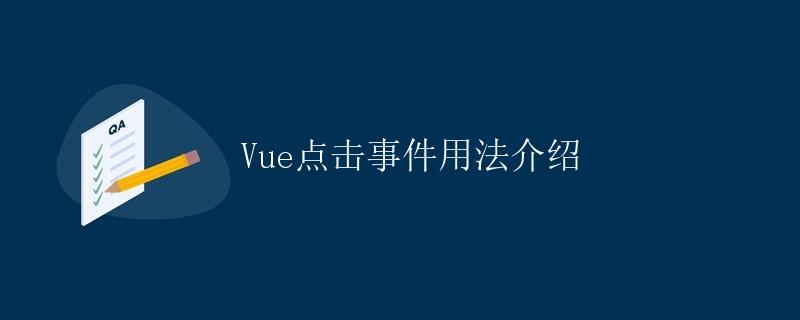Vue点击事件用法介绍

引言
Vue.js 是一款用于构建用户界面的渐进式JavaScript框架。它以数据驱动和组件化的方式,能够极大地简化前端开发过程。在Vue中,通过事件来响应用户的操作是非常重要的一部分。本文将详细介绍Vue中的点击事件的使用方法及示例。
点击事件的基本概念
在Vue中,点击事件是一种特殊的DOM事件,它会在用户点击某个元素时触发。通常情况下,我们通过v-on指令来绑定点击事件,并在事件处理函数中编写相应的逻辑。
点击事件的基本语法格式如下:
<template>
<button v-on:click="handleClick">点击按钮</button>
</template>
<script>
export default {
methods: {
handleClick() {
// 事件处理逻辑
},
},
};
</script>
在上面的代码中,我们通过v-on:click指令将点击事件绑定到了<button>元素上,并指定了事件处理函数为handleClick。当按钮被点击时,handleClick函数会被触发。
传递参数
有时候,在事件处理函数中可能需要传递一些参数。Vue提供了两种方式来传递参数给事件处理函数。
1. 直接传递参数
我们可以使用v-on:click="handleClick(arg1,arg2,...)"的方式,在事件指令中直接传递参数给事件处理函数。示例如下:
<template>
<button v-on:click="handleClick('Hello', 'Vue')">点击按钮</button>
</template>
<script>
export default {
methods: {
handleClick(arg1, arg2) {
console.log(arg1, arg2); // 输出 Hello Vue
},
},
};
</script>
当按钮被点击时,传递的参数会被按序传递给事件处理函数。
2. 使用$event对象传递参数
除了直接传递参数外,我们还可以使用$event对象来传递参数。$event对象是一个自动传递给事件处理函数的特殊变量,它代表了触发事件的原始事件对象。示例如下:
<template>
<button v-on:click="handleClick($event, 'Hello', 'Vue')">点击按钮</button>
</template>
<script>
export default {
methods: {
handleClick(event, arg1, arg2) {
console.log(event, arg1, arg2); // 输出事件对象和参数值
},
},
};
</script>
在上面的例子中,事件对象$event会被作为第一个参数自动传递给handleClick函数,而后面的参数arg1和arg2则是手动传入。
修饰符
Vue提供了一些常用的事件修饰符,用于处理一些特殊的点击事件需求。
.stop修饰符
.stop修饰符用于阻止事件冒泡,即阻止事件向上级元素传递。示例如下:
<template>
<div v-on:click="handleDivClick">
<button v-on:click.stop="handleButtonClick">点击按钮</button>
</div>
</template>
<script>
export default {
methods: {
handleDivClick() {
console.log('Div 被点击');
},
handleButtonClick() {
console.log('Button 被点击');
},
},
};
</script>
在上面的例子中,当按钮被点击时,只会触发handleButtonClick函数,而不会触发handleDivClick函数。
.prevent修饰符
.prevent修饰符用于阻止默认事件行为。示例如下:
<template>
<form>
<input type="submit" v-on:click.prevent="handleSubmit" />
</form>
</template>
<script>
export default {
methods: {
handleSubmit() {
console.log('Submit 被点击');
},
},
};
</script>
在上面的例子中,当提交按钮被点击时,会阻止表单的默认刷新行为,并触发handleSubmit函数。
.once修饰符
.once修饰符用于只触发一次事件。示例如下:
<template>
<button v-on:click.once="handleClick">点击按钮</button>
</template>
<script>
export default {
methods: {
handleClick() {
console.log('Button 被点击');
},
},
};
</script>
在上面的例子中,当按钮被点击后,再次点击将不会触发handleClick函数。
自定义事件
除了绑定DOM原生事件外,Vue还允许我们自定义事件,并在组件中使用。自定义事件适用于组件之间的通信。
组件内部自定义事件
首先,我们需要在组件中定义一个自定义事件,并在需要的时候触发该事件。示例如下:
<template>
<button v-on:click="handleClick">点击按钮</button>
</template>
<script>
export default {
methods: {
handleClick() {
this.$emit('custom-event', '自定义事件消息');
},
},
};
</script>
在上面的例子中,当按钮被点击时,通过this.$emit('custom-event', '自定义事件消息')语句触发一个名为custom-event的自定义事件,并传递一个消息作为参数。
接下来,在父组件中监听自定义事件,并处理相应的逻辑。示例如下:
<template>
<child-component v-on:custom-event="handleCustomEvent"></child-component>
</template>
<script>
import ChildComponent from './ChildComponent';
export default {
methods: {
handleCustomEvent(message) {
console.log('接收到自定义事件:', message);
},
},
components: {
ChildComponent,
},
};
</script>
在上面的例子中,父组件通过v-on:custom-event="handleCustomEvent"指令来监听名为custom-event的自定义事件,并在handleCustomEvent函数中处理事件消息。当子组件触发自定义事件时,父组件会接收到事件消息并打印出来。
非父子组件通信
有时候,我们需要在非父子组件之间进行通信,此时可以使用Vue的事件总线来实现。
首先,我们需要创建一个新的Vue实例,作为事件总线。示例如下:
// EventBus.js
import Vue from 'vue';
const bus = new Vue();
export default bus;
在上面的代码中,我们创建了一个名为bus的新的Vue实例,并通过export语句导出它。
接下来,在需要使用事件总线的组件中,我们可以通过引入EventBus.js文件来使用事件总线。示例如下:
<template>
<button v-on:click="handleClick">点击按钮</button>
</template>
<script>
import EventBus from './EventBus';
export default {
methods: {
handleClick() {
EventBus.$emit('custom-event', '通过事件总线传递消息');
},
},
};
</script>
在上面的例子中,当按钮被点击时,通过EventBus.$emit('custom-event', '通过事件总线传递消息')语句触发一个名为custom-event的自定义事件,并传递一个消息作为参数。
最后,在另一个组件中,我们可以使用相同的事件总线来监听并处理该自定义事件。示例如下:
<template>
<div>
<h2>另一个组件</h2>
<p>{{ message }}</p>
</div>
</template>
<script>
import EventBus from './EventBus';
export default {
data() {
return {
message: '',
};
},
created() {
EventBus.$on('custom-event', (message) => {
this.message = message;
});
},
};
</script>
在上面的例子中,通过EventBus.$on('custom-event', (message) => { this.message = message; })语句来监听名为custom-event的自定义事件,并在回调函数中将事件消息赋值给message属性。
这样,当一个组件通过事件总线触发自定义事件时,另一个组件会接收到该事件并展示出相应的消息。
结论
Vue中的点击事件是非常重要和常用的功能之一。通过本文的介绍和示例,我们了解了点击事件的基本用法,以及如何传递参数、使用修饰符和自定义事件。掌握这些知识,我们就能够灵活地应用点击事件,实现各种交互和用户操作。
 极客教程
极客教程